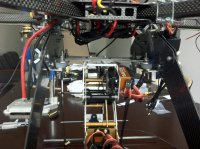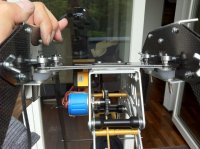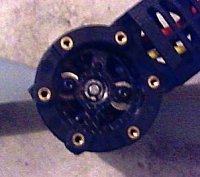I have been messing around with anti-vibration solutions for about four years now, starting with cameras mounted on a Raptor 50. I went through countless designs mostly based on suspending the camera frame. The 'camera frame', as I call it, was a rigidly made aluminium frame with a 2-axis gimbal at the front, electronics and servos in the middle and batteries + downlink at the back acting as a counterbalance to the camera weight.
The methods of suspension varied from hanging the long frame members in foam tube - very effective but delicate - to thin gauge bungee to home-made circular gel isolators on an aluminium tube. Occasionally the tension of the bungee was just right to allow the frame to hang without touching any of the vibrating helicopter, but most of the time they were too tight or too loose allowing the whole frame to wallow.
I was following the basic idea employed by manufacturers of underslung camera mounts that attached to the helicopter by hanging on the foam covered skids.
The point of all this is that most 'hanging' isolation methods - such as the silicon tube and bolts method - are not ideal because they allow the camera mount to swing around and possibly bounce. More reliable is gel under compression. This however takes a bit of ingenuity because the weight of the camera mount etc has to be applied ABOVE the isolators which is not always easy with the tiny spaces available on models.
The so-called isolators which are no more than stand-offs made with rubber are not very effective. Perhaps better than nothing but the rubber is just too hard and, once again, everything is hanging.
For the time being I am using a very basic mount on this relatively new Droidworx, the Highsight SLR2. Video results so far have been fairly promising and vibration has NOT been particularly evident. However, a few days ago it was quite windy and on that occasion I did not notice some hints of what could have been vibration. So I have modified the simple plastic standoffs that bolted directly to the underside of the lower chassis plate and installed some simple gel compression dampers using the gel pads that are sold by regular MR suppliers.
Three flights today with three different cameras (5D, NEX-5N, Panasonic HDC-SD9 camcorder) in very gusty conditions have shown them to be very effective.
It is an experiment and I will probably re-work it slightly because getting those little plastic nuts on is a *****.
Uncompressed ...
and compressed ....





